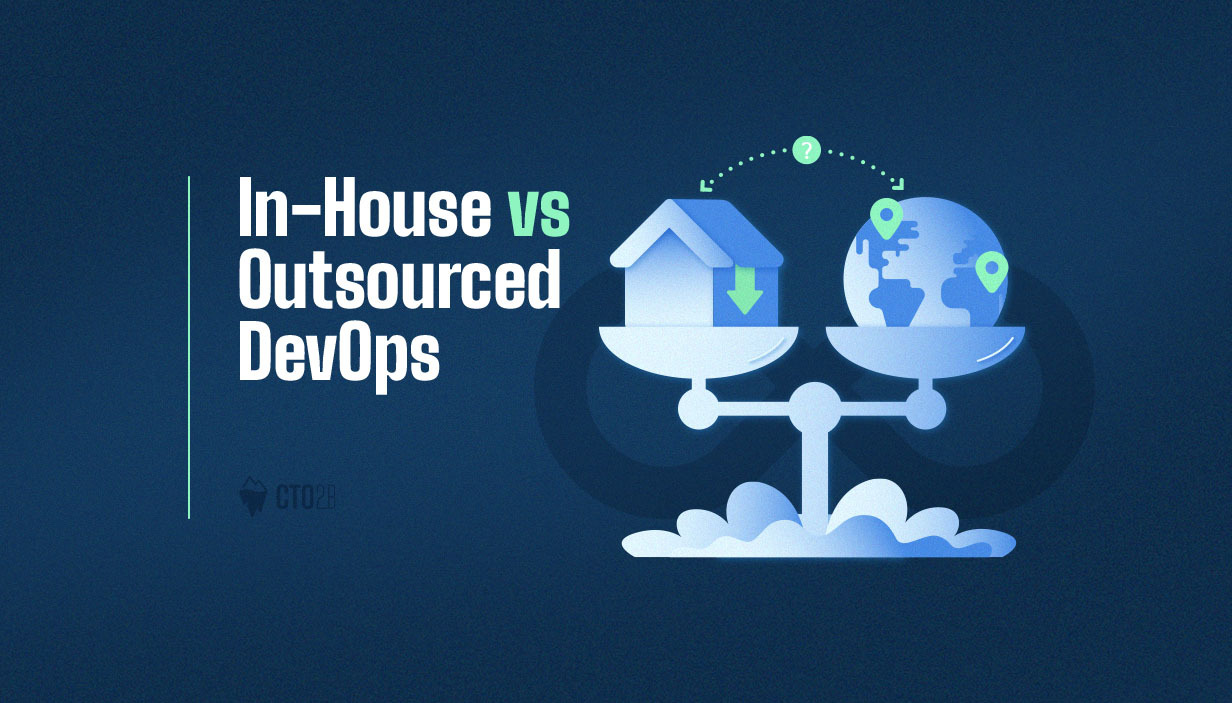DevOps is at the heart of modern software delivery, blending development and IT operations to improve speed, collaboration, and reliability.
But as your business grows, you’ll face an important decision: should you build an in-house DevOps team or outsource to external experts?
This guide breaks down both options, helping you choose the best fit for your goals, budget, and technical needs.
Making the right DevOps decision is especially important today, as businesses seek to stay competitive and adapt to rapidly changing technology trends.
What Is DevOps?
DevOps is a set of practices that brings together software development and IT operations. The goal is to speed up development, release more often, and deliver more reliable software.
Adopting DevOps helps your business stay agile, improve product quality, and drive innovation.
The role of DevOps is always evolving. It acts as a bridge between development and operations, helping teams work better together to meet business goals.
In-House DevOps: Overview, Pros & Cons
What Is In-House DevOps?
In-house DevOps means building and managing your own team of DevOps professionals. This gives you full control over processes and allows for customized solutions that fit your business needs.
Your team works closely with developers, IT staff, and other departments—often on-site—which makes communication and collaboration easier.
Hiring skilled DevOps talent is key here. Their deep knowledge helps strengthen security, streamline operations, and build long-term expertise within your organization.
Benefits of In-House DevOps
- Deep Integration: Your team understands your company’s culture, processes, and goals, leading to tailored solutions.
- Direct Control: Immediate communication and oversight help align DevOps efforts with business priorities.
- Enhanced Security: Sensitive data stays within your organization, supporting compliance and risk management.
- Custom Solutions: In-house teams can develop unique pipelines and workflows that better suit your specific needs.
- Enabling Customization: Having an in-house DevOps team provides greater control and understanding of your organization, enabling you to customize and optimize processes effectively.
- Enhanced Collaboration: In-house DevOps fosters enhanced collaboration with other internal departments, improving communication, information sharing, and integration for faster problem-solving and innovation.
- Institutional Expertise: In-house teams develop institutional expertise, yielding in-depth product knowledge, sustained knowledge retention, and close alignment with organizational objectives.
Challenges of In-House DevOps
- Higher Costs: Recruiting, training, and retaining skilled DevOps engineers is expensive, largely due to the high salaries required to attract top talent, especially in competitive markets.
- Talent Shortages: Finding qualified professionals can be difficult and time-consuming.
- Continuous Upskilling: DevOps is fast-evolving, so ongoing training is a must.
- Resource Allocation: Full-time staff may be underutilized during slow periods.
Outsourced DevOps: Overview, Pros & Cons
What Is Outsourced DevOps?
Outsourcing DevOps means working with an external provider who brings in the tools, talent, and processes needed to manage your DevOps pipeline.
This approach gives you access to skilled professionals who can help speed up delivery and reduce risks, without having to build a team from scratch.
It’s flexible, scalable, and often more cost-effective, especially for companies that don’t need a full-time in-house setup.
External partners usually bring advanced expertise you may not have internally, ensuring your DevOps practices stay sharp and up to date.
Benefits of Outsourced DevOps
- Cost-Effectiveness: Pay only for the services you need, without the overhead of full-time salaries and benefits.
- Access to Expertise: Tap into a broad talent pool of expert professionals with up-to-date skills and certifications.
- Scalability: Easily scale services up or down based on project demands.
- Faster Implementation: Providers offer established frameworks and processes for rapid deployment.
- Focus on Core Business: Free up internal resources to focus on your main business objectives.
Challenges of Outsourced DevOps
- Limited Control: Outsourcing can result in limited control over processes, which may lead to misalignment or delays.
- Communication Barriers: Time zone differences, language, and cultural differences may impact communication and coordination.
- Security Concerns: Sharing sensitive data with third parties introduces risks—choose partners with robust cloud compliance practices.
- Vendor Dependency: Relying on external providers can create challenges if priorities shift or contracts end.
Keep these important considerations in mind when selecting an outsourcing partner.
Key Comparison: In-House vs Outsourced DevOps
Cost
- In-House: Higher fixed costs—think salaries, benefits, recruitment, and ongoing training.
- Outsourced: More flexible and usually lower overall costs. You only pay for what you use, with no overhead for office space or equipment.
Expertise & Skills
- In-House: Deep knowledge of your systems, but limited by internal experience.
- Outsourced: Broader expertise and access to the latest technologies, such as DevOps automation and AI gateway solutions.
Control & Communication
- In-House: Real-time collaboration and easier alignment with your company’s goals.
- Outsourced: Requires clear contracts, regular check-ins, and open communication to stay aligned.
Scalability & Flexibility
- In-House: Scaling up requires hiring and onboarding, which takes time.
- Outsourced: Rapidly adjust team size and services as needs change—ideal for projects like cloud migration.
Security & Compliance
- In-House: Easier to enforce strict access policies and maintain access control management.
- Outsourced: Must vet vendors for compliance and data protection standards.
Cultural Alignment: Why It Matters in DevOps
Cultural alignment can make or break your DevOps efforts, whether you go in-house or outsource.
When your DevOps team shares your company’s values, work habits, and communication style, collaboration becomes much easier.
That’s especially important in DevOps, where trust, speed, and clear communication are key to success.
A strong cultural fit helps teams work better together on things like automated testing, continuous delivery, and faster releases.
If you’re considering outsourcing, make sure to assess how well the provider’s culture matches yours. This helps avoid confusion, ensures smoother collaboration, and increases the chances of success, whether your team is internal, external, or a mix of both.
DevOps as a Service (DaaS): An Emerging Alternative
DevOps as a Service (DaaS) is quickly becoming a popular option for organizations seeking a flexible, scalable solution that combines the best aspects of in-house and outsourced DevOps.
With DaaS, growing businesses can access high-demand expertise and advanced tools without the significant investment required to build and maintain an internal team.
This model is particularly well-suited for companies experiencing rapid growth or fluctuating project demands, as it allows them to meet their needs efficiently while keeping administrative costs in check.
By leveraging DaaS, organizations can accelerate delivery, improve quality, and focus on their core business goals, leaving the complexities of DevOps implementation to seasoned experts.
DaaS not only reduces the burden of hiring and training but also enables businesses to drive innovation and stay ahead in today’s competitive landscape.
For many, DaaS represents a strategic investment that delivers significant value, combining the agility of outsourced DevOps with the tailored support of an in-house approach.
Hybrid and Alternative Models (Including Outstaffing)
Some companies don’t choose just one path—they go hybrid.
In a hybrid model, you keep a small in-house DevOps team to handle core tasks, and outsource specific projects or extra workload when needed. It’s a smart way to stay flexible without losing control.
Another option is outstaffing, where external DevOps experts work as part of your internal team. Unlike traditional outsourcing, you manage their day-to-day tasks, which gives you more control while still benefiting from outside expertise.
Both approaches offer a nice balance between cost, control, and scalability—especially if your needs change over time.
Selecting a DevOps Service Provider: What to Look For
Choosing the right DevOps partner is key to making your projects successful.
Start by checking their experience, have they handled projects similar to yours? Do they have the skills and certifications you need?
Communication matters, too. Look for a provider that’s transparent, easy to reach, and willing to work closely with your internal team.
Make sure they’re strong in core DevOps practices like automated testing, continuous integration, and meeting deadlines.
Also, think big-picture: consider cost, scalability, security, and how well their approach aligns with your business goals.
The right partner will feel more like an extension of your team, not just a vendor.
Implementation and Integration: Ensuring a Smooth Transition
A smooth transition to DevOps requires careful planning, the right expertise, and a strategy tailored to your organization’s needs.
Begin by assessing your current processes, staff skills, and infrastructure to identify gaps and areas for improvement.
Develop a step-by-step plan that combines the right skills and tools to meet your goals, and invest significant time in training employees on new practices and technologies.
Onboarding new team members (whether in-house or outsourced) should be a priority, ensuring everyone is aligned and ready to collaborate. Implement changes incrementally, using thorough testing to minimize hassle and disruption.
By investing in your staff and focusing on collaboration, you can overcome challenges, build a strong DevOps culture, and maximize the return on your investment.
A well-executed implementation strategy not only meets your immediate needs but also sets the stage for ongoing innovation and performance improvements.
Monitoring and Evaluation: Measuring DevOps Success
To know if your DevOps strategy is working, you need to track progress regularly.
Start with clear goals, like faster deployments, fewer bugs, or better uptime. Then, use key performance indicators (KPIs) to measure how you’re doing.
Metrics like deployment speed, error rates, and recovery time can show where you’re improving and where you’re not.
Keep reviewing your results, adjusting your strategy as needed, and keep learning. That’s how you stay agile, efficient, and competitive.
Consistent monitoring helps you get the most out of your DevOps investment and keeps your team moving in the right direction.
How to Choose the Right Model for Your Business
There’s no one-size-fits-all answer. The right DevOps model depends on your goals, resources, and how your business operates.
Factors to Consider
- Business Size: Startups and small businesses often benefit from outsourcing, while larger organizations with complex needs may prefer in-house teams.
- Budget: Weigh the total cost of ownership, including hidden expenses.
- Project Complexity: Unique or highly regulated projects may require in-house expertise.
- Time-to-Market: Outsourcing can accelerate delivery when speed is critical.
- Internal Expertise: Assess whether you have, or can attract, the necessary skills.
- Security Needs: Sensitive industries may require tighter in-house controls or trusted cloud compliance partners.
Real-World Scenarios: When to Choose In-House or Outsourced DevOps
- In-House DevOps is ideal if:
- You handle sensitive customer data and require strict security.
- Your infrastructure is complex and highly customized.
- You want full control over DevOps processes and long-term investment in internal expertise.
- Outsourced DevOps is best when:
- You need to scale quickly or manage fluctuating workloads.
- Your budget is limited and you want to avoid high fixed costs.
- You lack in-house expertise for projects like cloud cost optimization or advanced automation.
- Rapid time-to-market is a priority.
Tips for a Successful DevOps Implementation
- Define Clear Objectives: Know what you want to achieve—faster releases, better uptime, cost savings, etc.
- Choose the Right Partners: If outsourcing, select providers with proven experience and positive references.
- Prioritize Communication: Establish regular check-ins and transparent reporting.
- Invest in Training: Whether in-house or outsourced, continuous learning is key.
- Monitor and Optimize: Use analytics to track performance and adjust as needed. For advanced solutions, consider integrating cloud infrastructure management.
Conclusion
Deciding between in-house and outsourced DevOps comes down to your goals, resources, and project needs.
An in-house team gives you direct oversight, stronger data security, and better alignment with your organizational culture, ideal for large enterprises or complex systems that need a deep understanding and tight source code control.
An outsourced team gives you access to a global talent pool, specialized expertise, and scalable DevOps services, a smart, cost-effective solution when you want to optimize costs and move fast.
Whichever path you choose, focus on long-term business value, strategic alignment, and building the DevOps capabilities that fit your project scope.
FAQs
What is the difference between in-house and outsourced DevOps?
In-house DevOps involves building your own team, while outsourced DevOps relies on external providers for expertise and management.
What are the main benefits of outsourcing DevOps?
Cost savings, access to specialized skills, scalability, and faster implementation.
When should a company choose in-house DevOps over outsourcing?
When security, deep integration, and long-term investment in internal knowledge are top priorities.
Is outsourced DevOps secure?
It can be, if you select reputable partners with strong cloud compliance and security protocols.
How do costs compare between in-house and outsourced DevOps?
Outsourced DevOps usually offers lower, more flexible costs, while in-house teams require higher, fixed investments.
Can a company use both in-house and outsourced DevOps teams?
Yes, many organizations use a hybrid approach for flexibility and coverage.
What is outstaffing in DevOps and how does it differ from outsourcing?
Outstaffing places external professionals within your team, offering more control than traditional outsourcing.
How do I choose the right DevOps model for my business?
Consider your size, budget, expertise, project complexity, and security needs.
What are common challenges with outsourced DevOps and how can they be managed
Communication and security are key challenges—manage them with clear contracts, regular updates, and thorough vetting.
What types of companies benefit most from outsourced DevOps?
Startups, small businesses, or any organization needing rapid scaling, cost control, or specialized skills.


